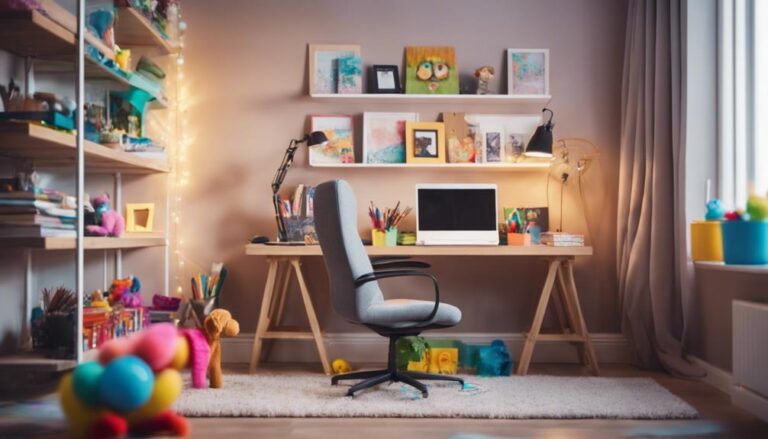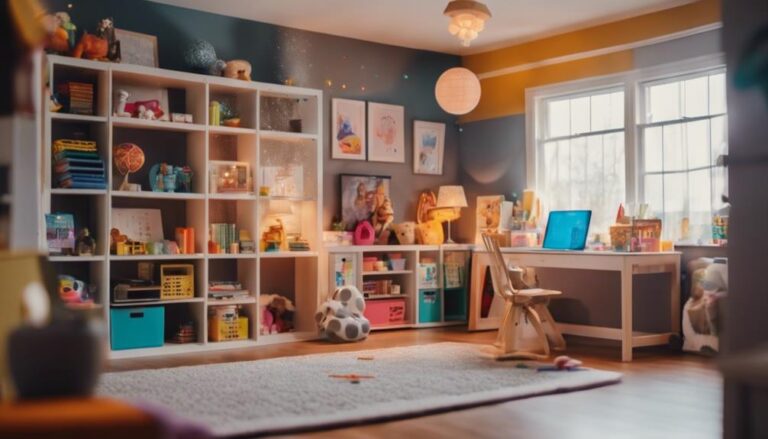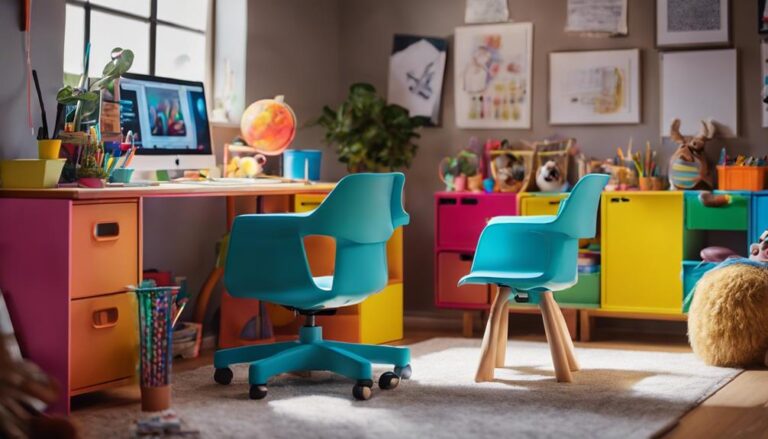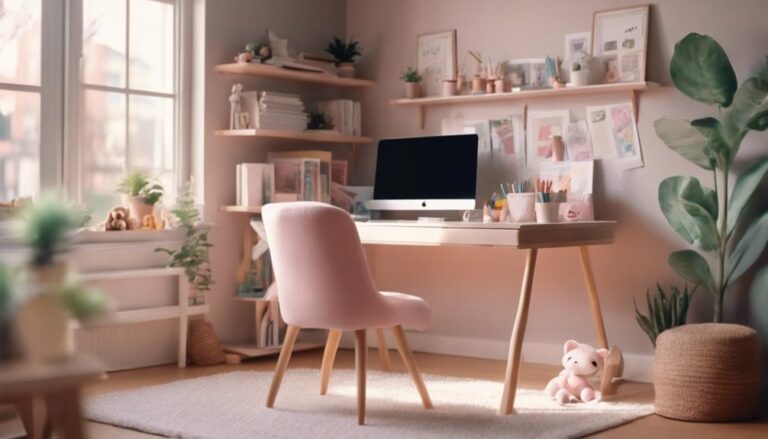Balancing work and kids at home can feel overwhelming, but I've found a few key strategies that really help. Create a child-friendly workspace with toys and books to keep them engaged. Set clear boundaries and communicate your work hours to everyone. Utilize nap times and quiet periods for focused tasks. Being flexible is essential, so consider negotiating a flexible work schedule. Don't forget to plan engaging activities for the kids and prioritize some self-care. These steps make a huge difference, and there's so much more to explore if you want to dive deeper into successfully managing both.
Key Takeaways
- Designate a specific workspace and set clear work hours to differentiate between work and family time.
- Utilize nap and quiet times to tackle demanding tasks and maximize productivity.
- Include age-appropriate activities and toys in your workspace to keep children engaged.
- Communicate your work hours and availability openly with family members to manage expectations.
- Embrace a flexible work schedule to effectively balance work responsibilities with parenting duties.
Create a Child-Friendly Workspace
How can I create a child-friendly workspace that keeps my kids engaged and safe while I work from home?
As a working parent, I know the challenge of balancing work and family life during work hours. Designating a specific area in my home for a child-friendly workspace has been a game-changer.
I include age-appropriate activities, toys, and books to keep my kids entertained. To guarantee safety, I set up a small desk or table for them to mimic my habits.
Child-proofing this space assures safety, allowing me to focus on my tasks. Maintaining a balance between work essentials and child-friendly elements creates a productive, welcoming environment for both my kids and me.
Establish Clear Boundaries
I've found that setting clear boundaries is essential when balancing work and kids at home.
By designating a specific workspace and setting clear work hours, I can signal to my family when I'm focused on work tasks.
This approach helps me maintain productivity while ensuring my family knows when they can count on my full attention.
Designated Work Spaces
Creating a designated work space at home can be a game-changer for juggling professional tasks and family responsibilities effectively. I've found that having a specific work area helps me draw a clear line between work and home, which is essential for maintaining a healthy work-life balance.
When I step into my designated work space, it signals to my family that I'm in work mode, reducing distractions and interruptions. This setup not only improves my focus and productivity but also helps me balance between work and family responsibilities more efficiently.
Set Work Hours
In addition to having a designated work space, setting specific work hours is key to establishing clear boundaries between professional tasks and family time. By setting work hours, I can clearly differentiate between my work responsibilities and parenting duties, which helps me stay focused and productive during my designated work time.
This approach also allows me to plan and organize my tasks more effectively, ensuring that everything gets done without overwhelming either my work or family commitments.
Consistent work hours contribute greatly to maintaining a healthy work-life balance, especially when working from home with kids. It's not just about working; it's about creating a rhythm that supports both professional growth and family well-being. Clear boundaries make it easier to switch roles and be present in each moment.
Communicate Expectations

Setting clear expectations with your family about your work hours and availability can make a world of difference in maintaining balance at home. I've found that when I communicate expectations openly, it's easier to establish boundaries. I clearly outline my work hours and make my availability known. Discussing family responsibilities with my partner guarantees we're on the same page. Here's a simple way to break it down:
| Task | Who's Responsible | Time Frame | Notes |
|---|---|---|---|
| Work Hours | Me | 9 AM – 5 PM | Do not disturb |
| Childcare | Partner | 9 AM – 12 PM | Rotate during breaks |
| Lunch Break | Me | 12 PM – 1 PM | Family time |
| Evening Family Time | Both | 6 PM – 8 PM | No work discussions |
Communicating openly about any conflicts helps address issues swiftly, keeping harmony at home.
Utilize Nap and Quiet Times
When my baby naps, I seize the opportunity to tackle my most demanding tasks without interruptions. This quiet time allows me to maximize productivity and stay organized, making my workday smoother.
I also plan quiet activities for my older kids, ensuring they're engaged while I focus on essential work.
Maximize Productivity Periods
As a parent juggling work and childcare, I've found that maximizing productivity during my baby's nap times is a game-changer. These predictable nap times provide the perfect window for uninterrupted work time.
By turning off distractions and diving into focused work, I can enhance productivity greatly. Scheduling meetings or handling intensive tasks during these periods allows me to efficiently utilize this quiet time.
This strategy helps me achieve more in a shorter amount of time, making it easier to balance work and parenting responsibilities. Embracing this innovative approach not only boosts my work efficiency but also guarantees that I can be more present and attentive when my baby is awake.
Plan Quiet Activities
While maximizing productivity during nap times is beneficial, planning quiet activities for when my child is awake can also guarantee a peaceful and focused work environment.
I've found that when I plan ahead and create activity boxes with engaging themes like art projects or science experiments, my child remains entertained, allowing me to focus on my tasks.
Utilizing nap times for intensive work or meetings enhances my productivity, but having a backup of quiet activities secures continuity.
Turning off distractions during these periods also maintains a calm atmosphere.
This strategic approach helps balance work demands and parenting, creating a harmonious and efficient work environment.
Balancing these elements lets me excel at both roles with innovation and foresight.
Incorporate Flexibility
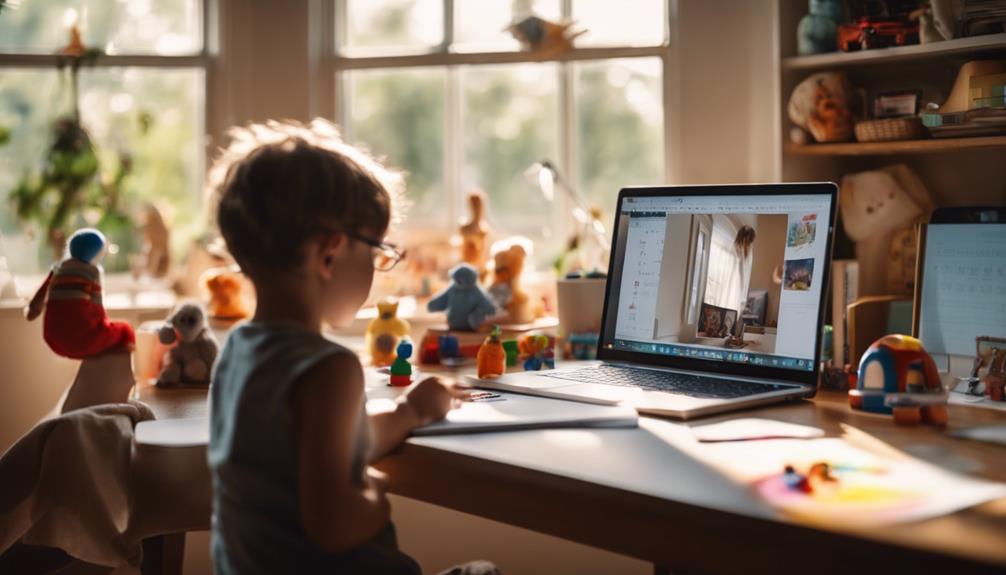
Requesting a flexible work schedule can make a world of difference in balancing the demands of work and family life. Flexibility is key for parents who work at home, as it allows us to carve out time to work when it best suits our family's rhythm.
By negotiating part-time options or adjusting hours, we can achieve the balance parents need to thrive both professionally and personally. It's essential to prioritize evenings and weekends for family and mental well-being.
As children grow, hiring additional help can alleviate stress and support this delicate balance. Embracing flexibility is vital, especially as the challenges of managing work and kids at home become more complex.
Plan Engaging Activities
Balancing flexibility with thoughtfully planned activities can make our days smoother and keep our kids happily occupied. When managing work and parenting, I've found that themed activity boxes brimming with art projects or science experiments can be lifesavers. Utilizing break times to join in these activities helps us spend more time together and creates valuable bonding moments.
Here's a quick guide I use:
| Activity | Benefits |
|---|---|
| Art Projects | Enhances creativity |
| Science Experiments | Sparks curiosity |
| Story Time | Boosts literacy skills |
| Outdoor Play | Promotes physical health |
| Puzzle Time | Develops problem-solving |
Prioritize Self-Care

Making time for self-care is essential to maintaining my sanity and well-being amid the daily juggle of work and kids. By prioritizing self-care, I can reduce stress and prevent burnout, which in turn boosts my productivity.
Simple activities like exercising, practicing relaxation techniques, or indulging in hobbies help me recharge. Allocating this time isn't selfish; it's a strategic move to create balance.
When I care for myself, I'm more present and effective both as a parent and in my remote work. Plus, I set a positive example for my children, teaching them the importance of self-compassion.
Remembering that my well-being is a cornerstone of our family's harmony makes self-care non-negotiable.
Frequently Asked Questions
How Can I Balance My Work From Home With Kids?
Balancing work from home with kids requires flexible scheduling and a designated workspace. I engage my children with activities and utilize time blocking. Incorporating self-care routines guarantees I'm refreshed and ready to tackle each day innovatively.
How Do I Manage My Kids Home and Work?
Juggling work and kids feels like spinning plates, but I establish routines, leverage virtual activities, and embrace flexible schedules. I take productive breaks and involve the family. It's all about finding balance and being creative.
How to Balance Time Between Work and Child?
Balancing work and child time's all about flexible schedules and time blocking. I take focused breaks, plan child activities, and share responsibilities. It's challenging, but innovative planning makes it manageable. You've got this!
How Do You Balance Work and Household?
To balance work and household, I use meal planning, chore distribution, and shared responsibilities. Family routines and designated spaces help too. We communicate openly and embrace teamwork, making our home run smoothly and efficiently.
Conclusion
Balancing work and kids at home can feel overwhelming, but with the right strategies, it's manageable. Did you know that 70% of working parents report increased stress levels? That's why creating a child-friendly workspace, setting boundaries, and communicating expectations are key.
Remember, it's okay to be flexible and use quiet times wisely. Most importantly, prioritize self-care. We're in this together, and with a bit of planning, you've got this!

